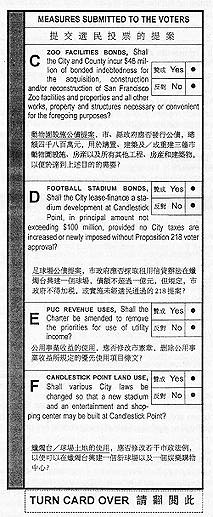 |
The new ballot design and reported polling place abusesFor the first time in a San Francisco election, the ballot, normally blank, was printed in such a way that an observer could easily tell at a glance how you voted - and no paper sleeve was provided for privacy as had been in all previous elections.In past elections, the voter sticks his blank ballot into a "voting machine," reads about his choices on the front of the machine, makes his selections, and his ballot is punched by the machine. The voter then carries his ballot (which can only be read by a computer card counter) to the ballot box protected in a paper sleeve. The process guarantees privacy. That the ballot was printed on both sides was, at the very least, an unfortunate decision. As any person experienced in direct mail will tell you, when you print an order form, you do everything you possibly can to avoid printing on both sides. Why? A certain percentage of people will fail to turn the card over, no matter how clearly you state the need to do so. Ominously, at least one eye witness claims that in one polling place, poll workers pointedly told voters not to enter selections on the back side of the ballot. The back side of the ballot squeezes in the descriptions of four propositions, three of them involving large grants to organizations that are not part of the city government: the zoo, which is owned by a non-profit foundation, and the 49ers football team. At the very least, this ballot was designed to give an edge to the stadium propositions. And given the report already mentioned and other reports of poll workers reading and attempting to set aside ballots, there may have been something far more sinister afoot. |